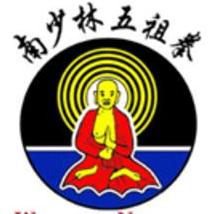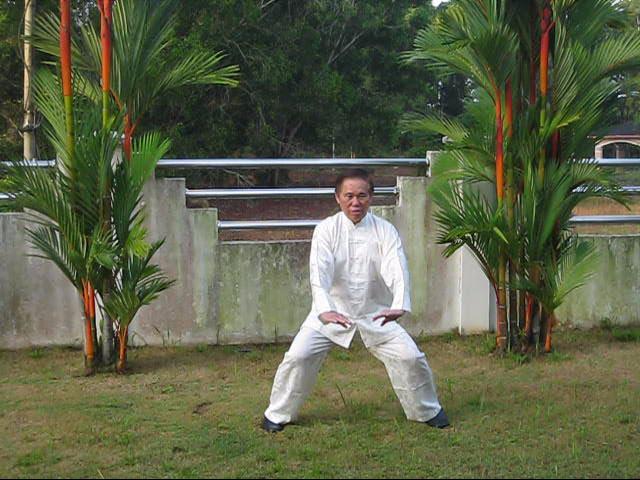SALIENT POINTS AND TRAINING METHODS OF WUZUQUAN

The logo of Wuzuquan schools from Grandmaster Chee Kim Thong's lineage
Question
Yes, Wuzuquan is descended from the Shaolin genre, but what are its key salient points that differentiates it from other Shaolin styles of Kungfu ?
-- Chin, Malaysia
Answer
For systematic discussion, we may consider the differences under four headings, namely philosophy, form, skills and application.
Wuzuquan originated as a Northern Shaolin style, formulated by a kungfu genius, Bai Yi Feng, at the northern Shaolin Temple in Henan during the Song Dynasty from five Shaolin styles, namely White Crane, Taizuquan, Lohanquan, Bodhidharma Style and Monkey Style.
However, over the years it became more Southern Shaolin in characteristics. This was mainly because Cai Yi Ming popularized it in Fujian of south China where Yong Chun White Crane was widely practiced. Hence, many Wuzuquan practitioners today are Fujianese speaking, and Wuzuquan is often known by its Fujian dialect of Goh Chor Kun.
This is an interesting salient point that differentiates it from all other Southern Shaolin styles. All other Southern Shaolin styles, like Hoong Ka, Wing Choon, Choy-Li-Fatt, Pak Mei, Dragon Style and White Crane originated from the southern Shaolin Temple. Wuzuquan is the only Southern Shaolin style (as it is now generally regarded) that originated from the northern Shaolin Temple.
Regarding form, a salient point about Wuzuquan that differentiates it from other Shaolin styles is profundity hidden in stark simplicity. Kungfu patterns of Southern Shaolin styles are quite elaborated. In Hoong Ka Kungfu, for example, there are dragon-hand, snake-fingers, tiger-claws, leopard-punch, and crane-beak.
But Wuzuquan patterns are bafflingly simple. In fact, when I first learned San Zhan, the fundamental set in Wuzuquan, I wondered how one could apply any San Zhan patterns against kicks, throws and qin-na (special ways of gripping). At first I thought San Zhan was only used for force training. It was only later when I studied it more deeply, I discovered that patterns from San Zhan could be used against any attack -- except if you are being pinned down on the ground.
Hence, San Zhan is complete by itself. In other words, by practicing only San Zhan, you can develop internal force and have enough fighting techniques to meet any attack. This is not so in most other Shaolin sets. In Choy-Li-Fatt, for example, you learn fighting techniques from kungfu sets, but hit sandbags or strike wooden man to develop force.
The Wuzuquan of Grandmaster Chee Kim Thong is famous for internal force. A salient point that differentiates it from other Shaolin styles is that its force is extremely soft, yet tremendously powerful. I clearly remember that my Siheng Chee Boon Leong, who taught us Wuzuquan on behalf of his father, Grandmaster Chee Kim Thong, constantly reminded us "mg mien yong lak" which is the Fujian dialect of saying "do not use strenght".
I wondered how one could fight effectively if he did not use strength. Earlier, when I learned Hoong Ka Kungfu from Uncle Righteousness, my sifu often told us "yong lek, yong lek", which is the Cantonese way of saying "use strength, use strength!" We hit a wooden man every night to develop force, and my arms were quite powerful. But when I sparred with my Wuzuquan classmates, my force was nowhere. Once my arms were so badly hurt that they had to be bandaged with medication for almost a week.
For combat application, Wuzuquan uses mainly strikes. Considering that it originated from Northern Shaolin where kicks were a forte, it is rather odd that kicks are not common in Wuzuquan. Felling and qin-na techniques are also few, and are hidden. This is a salient difference with other Shaolin styles. When viewing a performance of a typical Shaolin set, an informed observer can readily pick out felling and qin-na techniques in the set. But it is not so with Wuzuquan. When viewing a performance of San Zhan, for example, even Wuzuquan students of many years' experience may think there are no felling and qin-na techniques in the set. There are, but they are hidden from uninformed eyes.

San Zhan
Question
What are their training methods? How long did you study under Master Chee?
Answer
I trained in Grandmaster Chee Kim Thong's school for about two years, which was my shortest period in my training with all my four sifus.
My Wuzuquan training, like my training with Uncle Righteousness and Sifu Ho Fatt Nam in Shaolin but unlike my Wing Choon training with Sifu Choe Hoong Choy, was typically traditional. My Wing Choon training was privileged.
Traditional training was characterized by 5% learning and 95% practicing. Students normally did not know the meaning of what they were training, nor was there a time-frame to assess whether objectives had been realized. This was, and is, typical, of most kungfu schools.
Typically my Wuzuquan class taught by my Siheng Chee Boon Leong who started with stance training. This was followed by San Zhan solo practice, which took most of the training time. Then my Siheng or a senior would test our force in a San Zhan two-person practice. We concluded the class with sitting meditation. We did not use the usual lotus or half-lotus position, but what is known as the "Guan Yin pose". This went on for 2 years.
In contrast my Wing Choon training with Sifu Choe Hoong Choy was different. I chose the sets I wanted to learn, and he taught me behind closed doors in his clinic where I went for my traumatology (or kungfu medicine) training. (Sifu Choe Hoong Choy was also a very accomplished traumatologist.) Instead of taking a few months to learn a kungfu set, which most students do, it took me only 2 or 3 days.
It is interesting to compare the traditional method of teaching and learning kungfu used in most kungfu schools today with the method we use in Shaolin Wahnam. The keyword of the traditional method is "ku lian" or persistent practice, usually associated with sweet and toil.
Some practitioners seem to take pride in their long years of enduring, persistent practice, with statements like "It has taken me 20 years just to learn this set", implying that their art is so deep that it takes 20 years just to learn it. If they derive many benefits from their 20-year practice, that is fine, but if they are still weak and stressful, and cannot defend themselves even from simple attack, then they have wasted their time. Worse, they do not even have the mental clarity to realize it.
The keyword in our Shaolin Wahnam method is "attaining aims and objectives". We define our aims and objectives, practice according to proven methods, and assess our results within a given time-frame. We also make our practice itself fun. If we can achieve our purpose in 20 months, or even a few days, we do not want to practice for 20 years.
For example, in my planned Wuzuquan course in future our general aim is to have a comprehensive introduction to Wuzuquan in all the four dimensions of philosophy, form, internal force and combat application. In combat application, an objective is to apply Wuzuquan patterns against various forms of attack, including Boxing, Kick-Boxing, Muay Thai and Wrestling. We set only a few days to accomplish all these.
This does not mean we are going to neglect practice. We are very clear that in becoming a master, learning constitutes only 5% of the training time, 95% is practice. But we are going to set only a few days to have a comprehensive introduction to Wuzuquan according to our set aims and objectives. After the course, those who are interested to continue with Wuzuquan will set aside appropriate time according to their needs and aspirations for their practice.
LINKS
